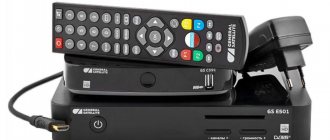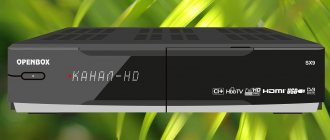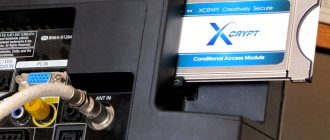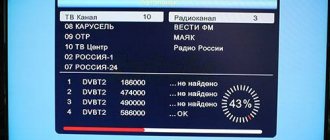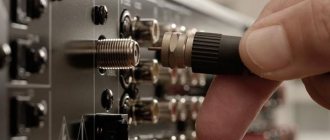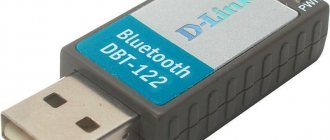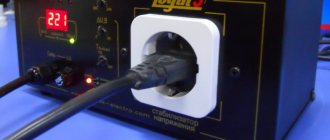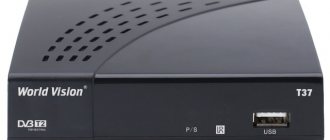The name HD (High-Definition) is familiar to almost every person. Today, the definition of “high resolution” applies to everything that is in any way related to the broadcast of video material - smartphones, cameras, displays and even smart glasses. But most often we hear this concept together with television broadcasting - HDTV.
Modern transmission of television signals is carried out using digital coding, and in order for the picture to be displayed on the screen, a special converter is needed - a receiver for the TV. What kind of equipment is this? What are the broadcasting standards? And how to choose the best device? Let's try to figure it out.
What is a digital receiver
Digital television is a method of receiving a television signal in digital format. New technologies allow broadcasters to broadcast the highest quality sound, images with improved clarity and a wider range of channels than was previously possible.
Before the advent of DTV (Digital television), analog signals were transmitted in a similar way to radio: in fact, the television video signal was transmitted in the AM band, and sound was transmitted on FM frequencies. As a result, analogue television transmissions were subject to interference, the image became snowy and distorted, depending on the geographic distance of the device receiving the signal.
Additionally, the amount of bandwidth assigned to an analog television channel limited the resolution and overall picture quality. The analogue television transmission standard was called NTSC (National Television System Committee). Its basis is 525 lines, 60 fields, 30 frames per second and a frequency of 60 Hz for video transmission. This is interlaced scanning, in which each picture is presented in two fields of 262 stripes, and then all the lines are combined into a single image.
These days, a common perception of digital television is that it is broadcast from signal towers that receive signals from satellites and transmit them to home receivers. The standard for such transmission is designated DVB-S2 or DVB-S. This is the magic of satellite transmission and it is reliable as long as the satellite is in sight.
However, this is not the only way to transmit television signals. Another popular method of transmitting digital video broadcasting signals is terrestrial, which is referred to as DVB-T. In this method, digital signals do not leave the Earth, but they are not transmitted via cable, but from antenna to antenna, from the signal provider to the home receiver. But the DVB-C standard is just cable digital television.
Digital television can be divided into three types according to the method of signal transmission:
- DVB-S2, DVB-S – satellite TV;
- DVB-C – cable TV;
- DVB-T2 – terrestrial TV.
Depending on the type of signal, the appropriate equipment is purchased: for DVB-S2, DVB-S - a satellite receiver, for receiving DVB-C - a cable digital receiver, and for DVB-T2 - terrestrial receivers. >
DVB broadcasters transmit data using a compressed digital audio/video stream. The new digital format can transmit several channels in one frequency band occupied by one analogue television channel, which makes it possible to more economically use the scarce radio spectrum. In addition, DVB provides many new features that analogue television could not offer.
Digital television is transmitted in a binary number system in the form of bits, just as data is created on a computer: music, video or audio content. A digital signal is built on two values: “1” and “0,” which determine whether the signal is “on” or “off.” The user always sees a clear image or his screen simply does not show anything, but there can be no interference, distortion or loss of color.
Since a DTV signal is made up of "bits", the same amount of bandwidth that a current analog TV signal occupies can accommodate not only a higher quality picture in digital form, but also additional space that can accommodate additional video, audio, and text signals.
The signal comes in digital, so it is important that the TV receiver can decipher and read it. If the TV operates in an analog system, then it will need an additional DTV converter - a digital receiver for the TV.
What is the job of a digital TV receiver and what is it for? To perform four main tasks:
- Receive and amplify digital television signals;
- Decode it and convert it to an analog signal for output via RCA or SCART connectors, or convert it to a digital signal for output via the HDMI port;
- Play multimedia content from USB drives;
- Perform the functions of recording, pausing and deferring television viewing.
Receivers are also often called set-top boxes, receivers, tuners, digital media renderers or digital television decoders. Such devices run on software, so their conditional access module can be easily reflashed, that is, the internal program can be changed. This means that this equipment never becomes obsolete, since its software content can be updated at any time.
The only characteristic that can make such a device irrelevant is the supported formats. If you have an old model of receiver that can only work with MPEG-2, then you will not be able to watch video in MPEG-4 format, and for this you will have to buy a new decoder model.
It is interesting to note that the transition from analogue to digital television is only one step. Although all HDTVs are digital televisions, not every digital television broadcast is HD, and not all digital televisions are capable of displaying high-definition images.
Specific Models
The satellite dish converter from Tricolor is popular because of its reliability, and you can buy it at an affordable price. It will not cost much, but will provide home owners with a high-quality signal.
Satellite head from Tricolor
ALYNO satellite television has a combined C+Ku converter based on two converters.
It has a dependent output “Ferret direct focus Twin-Twin”, which provides constant signal reception in two ranges at once: C and Ku. Works only in conjunction with the passive multiswitch 4/2. Made for offset antennas. Polyethylene caps.
Converter General Satellite GSLF-51E with waveguide diameter: 40 mm (standard); connector type: 75 F-type is also popular among subscribers.
Galaxy Innovations GI-301 converter is a circular polarization converter. It is very convenient to use in everyday life.
What are the broadcasting standards?
The A/V receiver is the center of your home theater. This is the electronic component that controls digital television. It connects:
- To the antenna (terrestrial receiver);
- To a satellite cable (satellite receiver);
- To a cable television network (cable receiver);
- To interactive TV (IPTV receiver).
Digital Terrestrial TV is a popular form of television for people migrating from analogue to digital services. Relatively hassle-free digital terrestrial TV is received through your existing TV antenna, providing minimal disruption to your TV viewing and little extra cost.
Digital satellite television, as the name suggests, refers to television that is received via a satellite dish, so to receive this format, you must have a satellite dish installed on the front of your home. There are no geographical restrictions on this service, since the digital television signal is transmitted directly from satellites in orbit. This technique is common in places where there are difficulties with broadcasting.
Digital cable television is delivered by the provider in a limited coverage area, through a network of high-speed fiber optic cables. To receive a signal via cable, the subscriber needs the receiver itself, an antenna, a converter and an AC power supply.
The most popular today are digital receivers for TVs of the DVB-T2 standard. They are the best at transmitting the broadcast signal because they do so directly, without additional devices for intermediate transmission or decoding of the signal.
Now, as for the formats:
- PAL, NTSC and SECAM are the most common analog formats that transmit images with a resolution of no more than 720 × 480 pixels;
- HDTV is a new digital broadcasting format, which means that the television picture will be high definition with a resolution of 1,280 by 720 or 1,920 by 1,080 pixels.
HDTV requires less bandwidth due to digital video compression. In addition, HDTV screens are about a third wider than tube TV displays, which is more consistent with the range of peripheral vision of the human eye, so they are more comfortable for viewing:
- The HD-Ready format has a resolution of 720p;
- Full-HD is 1080p.
Some receivers now have the ability to decode Dolby TrueHD and DTS Master Audio, which are found on some Blu-ray discs.
Why the whole world is switching to the “decimeter wave”
The transfer of television to DTV is an objective process that fits within the framework of global technological progress.
After all, this format has a number of advantages over analog television:
- increased noise immunity of the signal for recording and transmission, which dramatically improves the quality of sound and picture;
- reducing the power of transmitters while increasing the number of television programs that can be transmitted through the frequency range;
- the advent of high-definition television;
- creation of interactive television;
- the appearance of options (“To the beginning of the program” and “Record the program”) and the creation of television archives;
- transmission of useful information with a television signal (electronic program guide);
- appearance of radio channels on the air.
Thus, as a result of this replacement, Russians will have access to:
- 20 free TV channels, most of which could previously only be viewed on satellite and cable television;
- SD image quality (720 by 576 pixels);
- interactive participation in your favorite programs;
- additional options in the form of viewing video recordings on demand, recording a program, selecting subtitles and language, the ability to go to the beginning of the program and create your own TV archive.
The disadvantages of this television format include:
- unstable image with a weak signal (“the picture” simply crumbles into cubes);
- loss of signal during a thunderstorm;
- increased number of transmission centers when compared with analog TV.
Another serious problem with the new television broadcasting format arose during the transition to digital, which, as it turned out, is not suitable for televisions without a digital tuner that supports a certain data transmission standard.
The number of such televisions turned out to be so significant that the deadline for the final transition to digital was postponed several times. To speed up the process, the Russian authorities even launched an advertising campaign to tell the population why they need a receiver for an outdated model of TV, and to instruct the population on how to switch to a new TV broadcasting format.
How to choose a receiver for TV
To choose the right digital receiver model, you should pay attention to the following characteristics:
- Broadcast Standards;
- Supported formats;
- Connectors and interfaces;
- Antenna selection;
- Multiplex packages.
We have already discussed the standards, formats and antennas of television broadcasting above. When buying a decoder, you just need to know which TV standard comes into your apartment and through which cable it is supplied. The image format is selected depending on the capabilities of your television receiver. Any HD signal will be accepted, but it will be downscaled to the resolution your TV can handle.
Connectors are a very important compatibility parameter. The most common interfaces that can be found in receivers:
- RCA – video and audio signal in stereo format;
- HDMI – high definition digital multimedia;
- USB (different versions 2:0; 3:0) – serial interface for connecting peripheral devices;
- AHT – antenna input/output;
- Card Reader – for reading memory cards;
- Connector for connecting a power supply.
General characteristics
There is no best LNB, and there is no single parameter that would define this superiority. Converter is different from converter to converter, it cannot be characterized only by color, country of origin or the ill-fated noise indicator, which has been falsified for many years to improve sales.
A really good converter for a satellite dish is distinguished by a solid body that is resistant to weather conditions, especially the sun, because otherwise its body will crumble within a year. What is important is the repeatability of its parameters throughout the entire receiving range from bottom to top, the absence of gaps in frequencies or problems at the beginning of the reception band.
Here are the LNB characteristics that definitely deserve your attention:
| Execution | The converter housing must be made of high quality material that ensures complete sealing. It is good if the case has at least protection for the connectors to protect this area from moisture. Try to avoid products with a body in dark colors. The reason is simple: in the summer it will become excessively hot in the sun, which can lead to electronic failure or damage. |
| Noise level | The noise level introduced by an LNB into a system, better known as noise figure, is measured in decibels. Sensitive LNBs have a low noise figure and are able to receive weak satellite signals. The current standard is 0.1-0.3 dB. Noise values below 0.1 dB offered by some manufacturers border on magic rather than reflecting reality. |
| Gain | This characteristic is relevant when you have a long cable. The standard is 50-65 dB; in principle, all modern heads provide it. |
| Input | Incoming signal from a satellite dish (GHz). The most popular bands are 10.7-11.7 GHz and 11.7-12.75 GHz. Remember, the wider the range, the better. |
| Output | Output signal (MHz). The most popular ranges are 950-1950 MHz (horizontal polarization) 1100 – 2150 MHz (vertical polarization). |
| Local oscillator frequency (GHz) | For the range of 10.7-11.7 GHz it is 9.75 GHz, and for 11.7-12.75, respectively, 10.6 GHz. |
| Current consumption | Different models have different current consumption. |
| Guarantee period | It often turns out to be a decisive factor when choosing a model. For higher quality devices, manufacturers are not afraid to give it even for 5 years. |
Antenna selection and multiplex packages
An antenna for digital television must be decimeter, that is, be able to receive decimeter (UHF) waves. Such radio waves are in the range from 1 m to 10 cm, which corresponds to a frequency of 300 MHz to 3 GHz UHF.
Digital television multiplex is a set of channels or a television package. That is, not one channel is broadcast on one frequency, but several at once. One transmitter and a whole package of television broadcasts.
On the territory of the Russian Federation today you can watch two digital television multiplexes, each of which broadcasts ten channels:
- Package “RTRS-1” – Channel One, Russia-1, Russia-2 Match-TV, NTV, Channel Five, Russia “Culture”, Russia 24, Karusel, OTR, TVC.
- Package "RTRS-2" - REN-TV, SPAS, STS, Domashny, TV-3, Friday, Zvezda, Mir, TNT, Muz-TV.
Which channels will be included in these packages are decided differently every year, based on an open competition. The possibility of launching a third multiplex is being considered, but this is only in plans for now. The state is also working to expand the television coverage area of these packages as quickly as possible, so that any resident of even the most remote areas has the opportunity to install a receiver and receive digital television in their apartment.
Video processing
After transferring data from a video cassette to a digital medium, the video receives a resolution of 320x240, 480x320 or 640x480 - for VHS, Video8 or Hi8 formats, respectively. Of course, this is not enough for modern monitors, but analog video formats were designed for televisions with cathode ray tubes that support a resolution of 400x300 pixels.
The information from the cassette should be corrected, improving color rendition, brightness and contrast, and applying suitable filters. Modern video editors allow you to add captions over the video, replace audio tracks, merge videos with different formats, and even use chromakey to replace the background.
Hello dear visitors of seoslim.ru! After the boom in popularity of video cassette recorders in the late eighties, many people were left with sizable collections of music and movies on VHS tapes at home.
Sometimes I would like to remember my youth, review the masterpieces of world cinema and pop stars of the eighties.
But here's the problem. The old video recorder has long been out of order and is gathering dust in the closet, and no one has been producing modern equipment for playing VHS tapes for a long time.
In principle, you can buy a used VCR on Avito. However, experience suggests that such equipment will last a maximum of a couple of months. It's kind of a shame to throw money away.
Settings
A properly assembled converter does not require complex configuration. Only with the help of trimming resistors R10, R14, R15, R18 and R28, R32, R33, R36 is it necessary to achieve the desired signal bandwidth.
To configure the converter you will need:
- sound generator;
- digital frequency meter;
- oscilloscope.
Using a low-frequency generator and an oscilloscope or tube voltmeter, you should adjust the frequency response of the filters. Initially, we configure the upper channel in the circuit on the DA3-DA6 chips, then the lower one on the DA7-DA10 chips. We supply a signal from an audio generator with a level of up to 1 V and a frequency of 830 Hz to the converter input.
At the same time, we control the frequency with a digital frequency meter, and using an oscilloscope we observe the signal at the control point KT1.
With resistor R10 we achieve the maximum voltage level at the control point, while reducing the input level. Next, we connect the oscilloscope to the KT2 test point and, with the minimum input signal, use trimming resistor RI4 to achieve a symmetrical voltage after the limiting amplifier.
Using an oscilloscope, switch to KTZ and configure the active filter on DA5. We do this using R18, while the tuning resistor R15 must be set to the middle position. By gradually reducing the amplitude of the input signal from the sound generator, we achieve a maximum voltage level with a frequency of 830 Hz in the KTZ.
Then we connect the oscilloscope to the KT4 test point. Using trimming resistor R8 at this point we achieve a level of 2.1 V.
We similarly configure the second channel on DA7-DAW chips. Only the converter input is supplied with a signal from a sound generator with a frequency of 1000 Hz. Channel frequencies may differ from those shown.
This also depends on the individual hearing skills of the operator.
To receive signals from the air, we connect:
- converter input - to the low-frequency output of the receiver (transceiver);
- output - to the input of the computer sound card.
You should tune in to an on-air RTTY station with the receiver volume reduced to a minimum. It is useful to take the low-frequency output from the transceiver to the converter before the volume control so that the position of the volume control does not affect the input level of the converter.
The sensitivity of the converter is quite high, and does not require a high level of low-frequency signal to operate. For example, to receive RTTY, we launch the program on the computer and select a speed of 45.45 baud. By smoothly changing the tuning frequency of the receiver, we achieve a noticeable alternation in the glow of the LEDs HL1, HL2.
The setup can be considered complete when the LEDs blink alternately in time with the received signals. We control reception by text on the monitor screen.
If you do not have a frequency meter and a sound generator, you can use the panoramic tuning indicator of the MIX2.21 program in RTTY mode. In the initialization file MIX.INI of this program, you must first set the frequency to 1000 Hz. We connect the converter to the transceiver, find a carrier on the air and tune it to this frequency using the indicator so that the tuning pointer is exactly in the middle.
Next, by connecting an AC voltmeter with a high-resistance input to the output of the DA3 (KT1) microcircuit, by rotating the slider of the trimming resistor R10, we achieve maximum readings from an oscilloscope or lamp voltmeter. Similarly after DA5 (KTZ). This converter can be used with almost all programs.
There are many programs for digital communications on “www.cqham”, “www.qrz.ru”.
